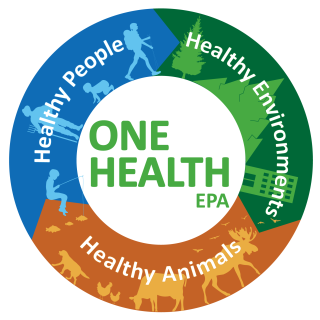One Health Research, Tools, & Resources

EPA researchers are working to develop ways to embrace the One Health approach as we work to safeguard the environment and protect public health. Below are examples of our One Health-related research and collaborations.
On this page:
- Antimicrobial Resistance (AMR)
- Harmful Algal Blooms (HABs)
- Total Environment Framework
- Report on the Environment (ROE)
- EnviroAtlas
- Protecting Watersheds, Sources and Drinking Water
- Climate Change
- Wastewater-Based Disease Surveillance
- Wildfires
- Air Quality/AirNow
- Pesticides
- Decontamination – Response to Biological Incidents
Antimicrobial Resistance (AMR)
Antimicrobial resistance is a growing global health threat. The National Antimicrobial Resistance Monitoring System, or NARMS, is a collaboration among state, local, and federal agencies to fight this public health threat. The EPA led a NARMS surface water project to develop the environmental component of the NARMS One Health program.
- A one health approach for monitoring antimicrobial resistance: developing a national freshwater pilot effort
- Developing and Implementing a Pilot Surface Water Monitoring Effort in NARMS (pdf)
- EPA Office of Research and Development Initiatives to Monitor Environmental AMR and Model Risk (pdf)
- Implementing a Pilot Environmental Effort for NARMS (pdf)
- Linking EPA to a One Health Focused National Scale Monitoring of Antimicrobial Resistance (pdf)
Harmful Algal Blooms (HABs)
Freshwater HABs can poison people, pets, and wildlife. EPA collaborates with the Centers for Disease Control and Prevention to summarize state and territorial reports of human and animal illnesses associated with HABs. CDC’s One Health Harmful Algal Bloom System started in 2016. As more states participate in the system, we’ll gain a better national estimate of the burden of HABs on human and animal health.
- CDC's One Health Harmful Algal Bloom System
- Harmful Algal Blooms & Drinking Water Treatment
- Climate Change and Freshwater Harmful Algal Blooms
- Cyanobacteria Monitoring Collaborative
- Cyanobacteria Assessment Network Application (CyAN app)
- NOAA: Harmful Algal Blooms - Tiny Organisms with a Toxic Punch
Total Environment Framework
Children’s neurodevelopment is complex because numerous chemical and non-chemical stressors are associated with neurodevelopment. Systems approaches can be used to assemble and evaluate evidence about the causes of childhood obesity and cognitive development using One Health approaches (e.g., Total Environment Framework)
Report on the Environment (ROE)
EPA’s ROE utilizes data from multiple sources to report status and trends related to the inter-connection between human health and the environment. The repository of information on status and trends is a knowledge management tool that can be used by One Health practitioners to explore relationships among key indicators.
EnviroAtlas
EPA ORD scientists combine large data bases via EPA's EnviroAtlas geospatial data and tool in new and novel ways to elucidate the relationships between human well-being, the well-being of other organisms, and the physical environment.
- EnviroAtlas
- EnviroAtals Eco-Health Relationship Browser (a subset of EnviroAtlas)
Protecting Watersheds, Sources and Drinking Water
EPA developed the watershed planning process to guide attainment of water quality standards. The staged process catalogs all sources of pollution, including humans and animals. Linkages are seen among all the various environmental compartments and could be used as a useful framework for One Health.
Climate Change
EPA is a leader in developing climate change impacts assessments across air and water quality, human health, ecosystems effects, and communities, both for EPA partners and as key contributions to the U.S. National Climate Assessment. The One Health framework can help in implementing future assessments of climate change impacts that integrate across health and ecological effects.
Wastewater-Based Disease Surveillance
Research indicates that, in many cases, wastewater surveillance can provide early warning of upcoming clinical infections in a population, such as SARS-CoV-2 (the virus that causes COVID-19). Information can be used to target and more effectively deploy public health interventions. EPA recently released a report on the practice of wastewater surveillance in the US.
Wildfires
Smoke from wildfires in the United States is adversely affecting air quality and potentially putting more people at health risk from smoke exposure. EPA, the USDA Forest Service, and other federal, state and community agencies and organizations are working together to identify ways the public can prepare to reduce their health risk before a wildfire. Public health officials and others can use the resources in the Smoke-Ready Toolbox to help educate people about the risks of smoke exposure and actions they can take to protect their health.
Air Quality/AirNow
AirNow is a partnership with federal, tribal, state, and local air quality agencies and displays the Air Quality Index (AQI), a color-coded tool for communicating air quality to the public so they can take actions to improve health. The Fire and Smoke maps display the AQI for fine particulate matter (PM2.5), including from wildland fire smoke. PurpleAir sensor data help fill gaps, increasing information provided to the public on local air quality, health effects and appropriate actions.
Pesticides
If used inappropriately, pesticides can cause harm to people, pets, wildlife, or water. If pesticides impact a species’ population, this impact may affect other areas of the food chain. EPA has a rigorous, science-based approach to ensure that pesticides can be used without causing any unreasonable adverse effects. The extensive process assesses risk on potential human health and ecological exposures.
Decontamination – Response to Biological Incidents
When cleaning up after a biological contaminating event, EPA considers the fate and transport of the biological hazard in the environment (air, water, soil, and built environment). To support wide-area decontamination strategies, EPA studies the efficacy and health effects of the decontaminants used to neutralize the hazard and how to manage waste generated. EPA works to produce environmental countermeasures against hazardous biological releases to the environment to protect humans, animals, and plants. Examples include:
- Subway (Built Environment): Exercise decontamination strategies
- Reducing decontamination wastewater generated and runoff to stormwater systems and natural waterways
- Working with USDA and states on carcass waste management
